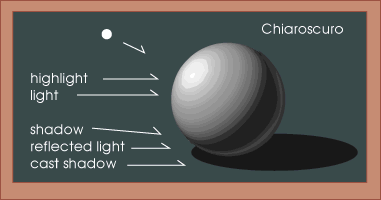
Unit 3 - Secret History
Influential Perspectives/Theories
In this unit the aim is to research possible secret techniques and processes used in art by 15th century artists. I will provide information and proof of their secrets to develop realistic images. I will also provide my own opinion on whether I consider using these techniques as cheating.


David Hockney published a book in 2001 called 'Secret Knowledge' where he explained that various painters of the Renaissance used optical devices to project images of their subject from which they then traced their compositions. He says many artists used these devices on paintings such as the one below.
Both images of a chandelier on the right side were painted entirely by eye. Hockney and Falco claim the chandelier is in perfect perspective, suggesting this could only have been achieved if traced from an optical projection.
Many experiments have been done by artists to test if it was possible to paint this chandelier with a perfect alignment of the arms. This proved very difficult and Hockney mentioned this and claimed it could have only been done using optical devices.
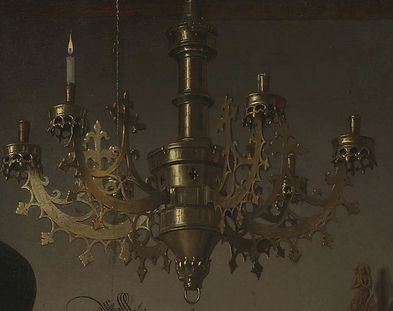
Research - Photography
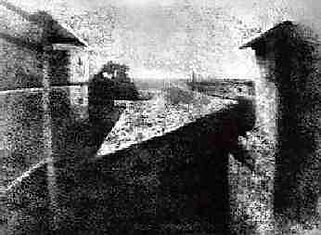
Photography was originally created in England and France however when it was developed it wasn't as advanced as it is now. Photography changed art during 1420 due to the camera lenses. The lenses allowed artists to perceive different views easier in their paintings and also create paintings of more complexity. When photography was invented, many artists had their income decreased as art itself had lost its worth. People were able to take photos which had more benefits than purchasing paintings off artists. Some of the benefits included more detail and realism in photos, no skills required to take photos, no need to spend money on paintings from artists and a faster way of having a physical representation of what you wanted. I will talk about the impact of photography on art later in the unit. In addition I will discuss my opinion on whether art was ruined by photography or not.
Research - Photorealism
This photoreal image of some peppers are very detailed and the light shining on the peppers is clearly shown. The three red peppers are presented in various angles to show different perspectives. The light can be clearly seen shining on the left side of the peppers and it presents the peppers with different colours depending on which angle it is viewed. The greens on the right side, next to the peppers bring out the stalks of the other peppers and also clearly show the light shining on them. I don't think that this image looks entirely realistic and some parts are clearly painted such as the two big peppers. However the good use of lighting does highlight the smaller peppers very well.


The next photoreal image of a ladybug crawling on a leaf, clearly shows the light shining on the ladybug and also highlights the rain. You can see all the small stems on the leaf and the blurred background helps focus on the ladybug and the leaf. The light shining on the ladybug expresses its red back. I think that this photo looks the most realistic out the three images that I have chosen because I like how the focus is only on the leaf and the ladybug instead of the whole image. This helps with emphasising the important details of the image.
This photoreal image shows the reflection of the objects very well such as the coffee, cup, plate and the spoon. The dark, brown table complements the white cup and plate as it emphasises the colours and its shadows. The light reflecting off the spoon looks very impressive and must have been difficult to create. I think that this image doesn't really look incredibly realistic and you can see that the cup, plate and spoon are painted, however the background and the surrounding objects like the table, floor and black chairs do look very realistic almost like pre-made background images.

Impressionism

Impressionist art or impressionism is an art style that mainly focuses on expressing emotion and feeling as opposed to realism. Impressionist art is usually very colourful and are bright and vibrant. The movement gained its name after the French critic Louis Leroy, reviewing the first major Impressionist exhibition, seized on the title of Claude Monet's painting Impression, Sunrise (1873), and accused the group of painting nothing but impressions. After the group was insulted by this, they used it as a way of creating a new art movement that doesn't focus on detail and realism, instead it would concentrate on the feeling of the scene that was painted.
Some of the greatest impressionist artists were Edouard Manet, Camille Pissaro, Edgar Degas, Alfred Sisley, Claude Monet, Berthe Morisot and Pierre Auguste Renoir. Manet influenced the development of impressionism.



Cubism
Cubism was a modern art style created by Pablo Picasso and Georges Braques. It was the first style of abstract art which evolved at the beginning of the 20th century in response to a world that was changing with unprecedented speed. Cubism was an attempt by artists to revitalise the tired traditions of Western art which they believed had run their course. Photography had begun to replace painting as the tool for documenting the age and for artists to sit illustrating cars, planes and images of the new technologies was not exactly rising to the challenge. Artists needed a more radical approach - a 'new way of seeing' that expanded the possibilities of art in the same way that technology was extending the boundaries of communication and travel.
I personally am not a huge fan of the cubism art style as I think that most of the art looks quite bland and generic. I understand that it was a way of artists competing with photography by showing a different perspectives in paintings, however I prefer styles such as impressionism more.



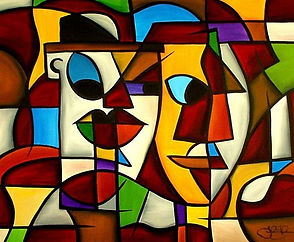
Cezanne

Paul Cezanne was a French artist and impressionist painter. Cezanne is said to have formed the bridge between late 19th-century impressionism and the early 20th century's new art style, cubism. Cezanne's early work is often concerned with the figure in the landscape and includes many paintings of groups of large, heavy figures in the landscape, imaginatively painted. Later in his career, he became more interested in working from direct observation and gradually developed a light, airy painting style. He uses basic shapes in his paintings like spheres and cones, as Cezanne believed that these shapes composed the basic foundation of nature.

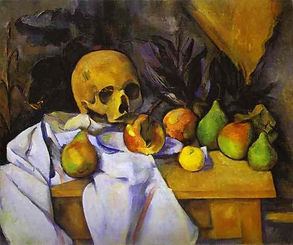

Did the Camera Kill Art?
The Camera did not kill art to the extent in which artists were unable to compete with photography. There is a distinct difference between photography and art, photography captures the most accurate representation of a scene in image form. However art can be categorized in variety of definitions. Artists are able to create accurate and detailed images of scenes, but they can also create scenes in different artistic styles such as Cubism, Impressionism and Cezanne, all artistic styles that I'll go into more depth later on.
Various art movements were created and rose to popularity to compete against photography and the Camera. One of them was Cubism. Cubism was a modern art style created by Pablo Picasso and Georges Braques and was the first style of abstract art which evolved at the beginning of the 20th century. Cubism was an approach by artists to expand the perspectives in which paintings were viewed. Cubism artwork are usually composed of many shapes and colours, this allows the paintings to be perceived differently depending on your view.
Another art movement that was created to compete with photography was Impressionism. Impressionism is an art style that mainly focuses on expressing emotion and feeling as opposed to realism. The movement gained its name after the French critic Louis Leroy was reviewing the first major Impressionist exhibition and accused the group of painting nothing but impressions. After the group was insulted by this, they used it as a way of creating a new art movement and only focusing on impressions.
Cezanne was another movement created by Paul Cezanne formed a gap between late 19th-century impressionism and the early 20th century's new art style, cubism. The principle of Cezanne is that everything in nature uses basic shapes such as spheres and cones. When viewing Cezanne artwork, these simple shapes are used and the bright colours from impressionist art is also seen.
Many believe that 15th century artists used secret techniques to help develop certain elements in images/paintings. The Hockney-Falco thesis states that certain elements in certain paintings made as early as 1430 were produced as a result of the artist using either concave mirrors or refractive lenses to project the images of objects illuminated by sunlight onto the board. Then traced some portions of the projected images, made sufficient marks to capture only the optical perspective of other portions, and altered or completely ignored yet other portions. In my opinion this is not considered cheating because these techniques and devices were just used to develop areas of an image that was difficult to create. However I do understand that this can be viewed as deceptive and not a representation of real artistic skill.
There isn't any actual proof of artists using optics to improve paintings, however David Hockney published a book in 2001 called 'Secret Knowledge' where he explained that various painters of the Renaissance used optical devices to project images of their subject from which they then traced their compositions.
In conclusion, the camera did not kill art because its purpose was to create realistic representations of a scene. In my opinion art and photography are completely different as art has various meanings, as opposed to photography which is electronically or chemically, creating durable images.
Beyond Caravaggio - Background Information


'Beyond Caravaggio' begins by exploring Caravaggio’s early years in Rome, where he produced works depicting youths, musicians, cardsharps and fortune tellers. These paintings were considered highly original on account of their everyday subject matter and naturalistic lighting. Bringing together exceptional works by Caravaggio and the Italian, French, Flemish, Dutch, and Spanish artists he inspired, ‘Beyond Caravaggio’ examines the international artistic phenomenon known as Caravaggism.
‘Beyond Caravaggio’ is the first major exhibition to explore the influence of Caravaggio on the art of his contemporaries and followers.
After the unveiling of Caravaggio’s first public commission in 1600, artists from across Europe flocked to Rome to see his work. Seduced by the pictorial and narrative power of his paintings, many went on to imitate their naturalism and dramatic lighting effects.
Paintings by Caravaggio and his followers were highly sought after in the decades following his untimely death at the age of just 39. By the mid-17th century, however, the Caravaggesque style had fallen out of favour and it would take almost three hundred years for Caravaggio’s reputation to be restored and for his artistic accomplishments to be fully recognised.
Beyond Caravaggio - Personal Thoughts

Painting Name: The Denial Of St Peter
Artist: Persionante del Saraceni
Date: 1615 - 1620
In this painting I like how the focus is on the action of the characters. The background and areas of the character's clothing has been blurred out to put all the concentration on the characters speaking to each other. The detail of the faces and the clothing really stands out to me and it clearly shows to the viewer that some kind of argument is taking place in the painting.
The picture was painted in the last months of Caravaggio’s tempestuous life and marks an extreme stage in his revolutionary style. Peter is shown before a fireplace, when a woman accuses him of being a follower of Christ. The pointing finger of the soldier and two fingers of the woman allude to the three accusations and to Peter’s three denials.
Abstract Expressionism - Background Information


Abstract Expressionism is a modern art movement that flourished in the post-World War 2 era, primarily in the United State. It includes mostly paintings, although some sculpture and other art forms are associated with the style as well. The artworks are non-representational, meaning there are usually no recognisable objects depicted. Large canvases and visible texture are common characteristics of the paintings. Another is the tendency for the artist to use an 'allover' style, filling the painting space without creating a specific focal point. Colour is perhaps the most striking and vital element, canvases saturated with one or more intense colours are hallmarks. The intention of the artworks usually focuses on inviting an emotional rather than an analytical response.
Abstract Expressionism - Personal Thoughts

Painting Name: Twelve Rules for a New Academy
Artist: Ad Reinhardt
Date: 1953
This painting on initial look just looks like a plain black square, however when looking more closely you can see the darkness and a symmetrical cross shape, filling the canvas, painted in extremely dark shades of blue and red. There is actually no pure black in the painting as Reinhardt carefully layered very dark shades of colour in matte oil paint. Reinhardt missed black and small amount of red oil paint in jar, which he then filled with turpentine. After leaving the mixture to settle for at least a week, Reinhardt drained off the turpentine along with the lighter part of the oil pain, leaving a very thick dark silt.
Reinhardt painted this as he was very interested in Eastern philosophy. He was inspired by Zen Buddhism as it focused on ascetic detachment from material items and emphasis on meditation. This is expressed in the painting as it slows down the experience of looking for the meaning of the painting. It gives viewers an unmeditated experience of art.
Abstract Expressionism - Art Terms
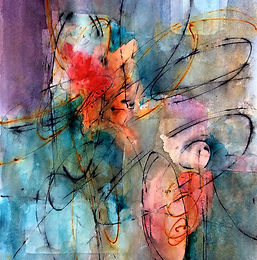
Abstract Art
A style of art in which the subject is represented in a less than realistic way, to one degree or another. Shapes and forms are sometimes distorted, unrealistic colours are sometimes used, and so on.

Action Painting
A work of art created by moving the whole arm rather than just the wrist and hand. Also called 'gesture painting'. Jackson Pollock, Franz Kline, and Same Francis used this technique.

Allover Painting
An artwork in which the canvass completely covered with paint and which gives equal emphasis throughout, with no distinct focal point. Artworks by Jackson Pollock and Mark Tobey used Allover Painting.
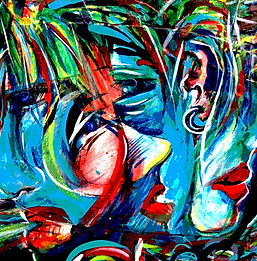
Automatism
A term borrowed from philosophy to describe actions performed without conscious thought, such as breathing. Applied to art that is created without conscious thought or drawing on the subconscious.

Colour Field Painting
An artwork characterised by large areas of colour, usually with no subject other than the colour. Works by Mark Rothko and Clifford still are representative of this technique.
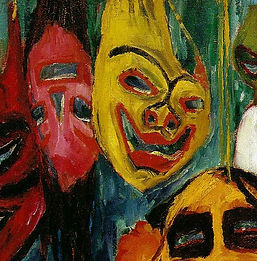
Expressionism
An art form that emphasises the depiction of deep feeling, emotions, or experiences.

Nonobjective
Not representing a person, place or recognisable thing. Also called 'nonrepresentational art'.
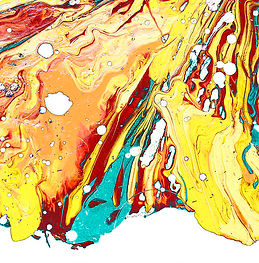
Stain Painting
A technique in which paint is thinned significantly and seeps into the canvas when applied. Stains are typically applied in layers. The works of Helen Rosenthaler and Paul Jenkins are representative of this technique.
Chiaroscuro - Light & Dark
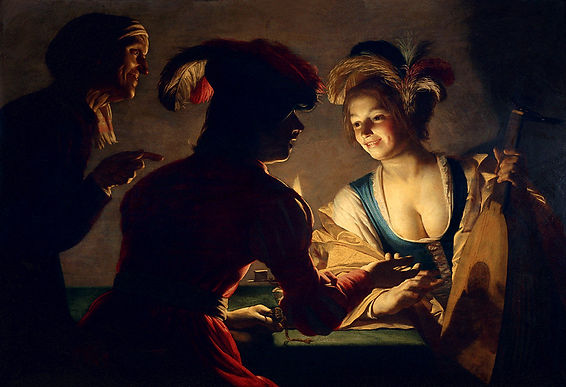
Chiaroscuro is an art term simply meaning 'light and dark'. In paintings the description refers to clear tonal contrasts which are often used to suggest the volume and modelling of the subjects depicted. Caravaggio is one of many artists who used this techniques in paintings. He used such contrasts for the sake of drama and to point out the main focus of his paintings' meanings.
